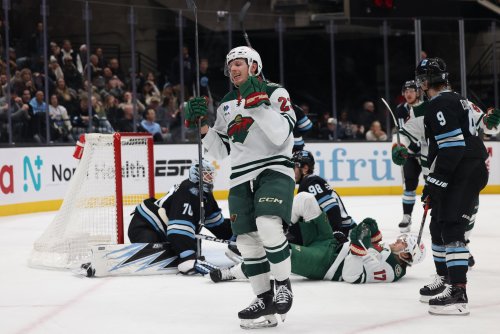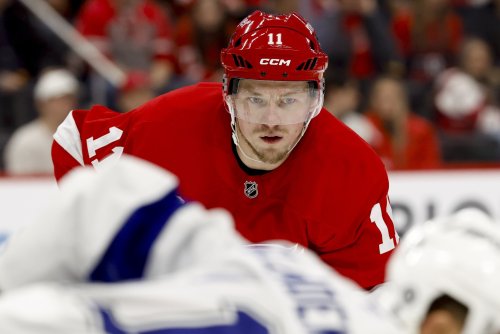
For those that know the basics about the Minnesota Wild roster, high grades for our top defensemen are run-of-the-mill. For the better part of a decade, Minnesota has been an environment in which goaltenders’ shooting percentages skyrocket and forwards pad their plus/minus rating.
The reason for this is a group of three or more elite defensemen who smother the rush on defense, clear the net, are great in the corners, make good breakout passes, support the offense in transition, and handle the puck on offense. This year, those guys were Spurgeon, Dumba, and Brodin.
Overall, we saw elite seasons for two of these guys and a bit of a drop-off from the other.
Jonas Brodin
Matt Dumba and Jonas Brodin are best friends off the ice, and have been joined at the hip for several seasons. Their underlying numbers are excellent together due to their great individual skills which fit together like two pieces of a puzzle. I will do what I can to grade them individually, but keep in mind that part of what makes them valuable is that they have such unique and complementary play styles that are perfect for the modern NHL.
For this reason, you can learn a lot about these guys by looking at the other guy.
This year, Dumba played 1036 minutes at 5-on-5, and 767 of those minutes were with Brodin. That pairing had a 55.8% advantage over the other team in expected goals (xG), a metric which quantifies the volume and quality of scoring chances based on location and play-speed (moneypuck.com). Among pairings with 200+ minutes played together, that’s the 28th-best mark in the league, on the bubble of a first or second pairing in the league. Where they really stood out was in xG-against, where they were the ninth-best pairing on a per-minute basis in spite of often matching up with the opposing team’s most potent offensive weapons.
The rest of Dumba’s time five-on-five was spent paired with Jordie Benn (106 min), Alex Goligoski (63 min), and Jon Merrill (55 min). Please note that the math isn’t perfect as I’m leaving off the other little bites of time he played with other partners. In these pairings, the xG% hovered between 45% and 49%, and none of them put up a better xG-against per minute.
This isn’t to say that Dumba is a below-average player, but rather it shows just how much better the impacts are when Brodin joins him. Dumba has a reputation for defensive mistakes (largely unearned, which we will get to in a moment), but placing Brodin at his side creates one of the very best defensive pairings in hockey.
Brodin is consistently deployed as the eraser when the Wild play against the best of the best - Connor McDavid, Nathan MacKinnon, really any world class forward. The reason for this is not only that Brodin has good defensive instincts and technique — his superpower is his skating.
The only ding on Jonas Brodin is that in spite of his world-class skating and even some solid rookie production, Brodin doesn’t engage offensively. He also leaves some space when defending his own blue line which prevents him from creating as many counterattacks or forcing opponents offsides. These are minor problems for a defenseman with such solid underlying numbers, but they are the reason he has never truly entered the Norris Trophy conversation.
Next time the Wild host an elite forward, whether you’re watching at the Xcel Energy Center or from home, make sure to watch that player — but also watch Brodin. He will play most of that guy’s minutes and shut him down, and you’ll see exactly what makes him so special.
Grade: A-
Matt Dumba
Dumba played well this year in a different role than what most Wild fans are used to. While he only put up seven goals, his 20 assists were his best mark of the last four seasons.
As I pointed out before, you can learn a lot about Brodin by looking at his partner with and without Brodin on the ice.
Doing the same back-of-the-napkin with-or-without-you analysis (my BOTNWOWY metric coming soon), I’m surprised to see that Dumba comes out looking much worse than Brodin. Overall, when Brodin played with Dmitriy Kulikov (289 min), Spurgeon (92 min), Goligoski (58 min), and Jordie Benn (46 min), it out-performed the Dumba-Brodin pairing.
From this, I draw two conclusions: the first is that it’s a great example of the limitations of this type of statistical analysis - in this case you’re missing something to the effect of deployment and quality of competition, while also opening the door to small sample sizes.
The second conclusion is much more interesting to anybody who loves or hates capital-a Analytics — these pairings that coaches keep together for years generate a huge sample size, but are sometimes totally unsuited for analytics because their chemistry changes the game. While it appears that Dumba is dragging down Brodin statistically, you have to remember that these two love to do opposite things which require support from their opposite. If Brodin won’t engage offensively, he needs Dumba to threaten the opponent into playing honest defense — otherwise, they can press harder on Brodin without fear of giving up dangerous chances.
Dumba also makes major contributions outside of the above five-on-five analysis: he is Wild’s only right-handed weapon on the power play. While he is less of a focal point since Kirill Kaprizov came to town, his shot remains extremely effective even after his pectoral injury in 2018-19. While his goal-scoring pace has declined since his return, keep in mind that it coincided with the power play focus shifting to Kevin Fiala and then Kirill Kaprizov.
This is why you see Dumba’s shooting percentage go down, and yet MoneyPuck’s xG model shows that he’s still shooting about as well as he did before the injury, relative to the danger of those shots. In 32 games in ‘18-’19, he had 6 power play goals - since then, he’s played 177 games and scored 3 goals. Because he’s now in a better fit on the second power play unit, goal scoring rate has dropped, but he’s just as dangerous.
Along with the blistering shot, Dumba brings much-needed physicality to the Wild’s defense corps, adding energy and usually making a solid defensive play in the process.
We will also be adding half a letter grade to Dumba’s season for the energy he brings, which is precisely why he has an A on his jersey:
Grade: B
Jared Spurgeon
Of the Wild’s top-three defensemen, Jared Spurgeon is certainly the most valuable. He doesn’t have quite the skating ability of Jonas Brodin and he doesn’t shoot quite as hard as Dumba, but he’s nearly ask skilled in both regards and has better hockey sense.
That may surprise you, but frankly it is flat-out true. This is the reason that Spurgeon plays with multiple defense partners, why he plays a major role in all situations, and why you see him rarely get burned while making an aggressive play while still taking risks at a high rate.
In this play, Spurgeon pinches below his goal line — you don’t often see a defender “forecheck” during a highlight. Spurgeon’s head is up and he immediately finds the best play the Wild can make (Kaprizov in the slot). Note also that as he starts making the play he is preparing to back-skate if necessary, but after seeing two Wild players at the blue line he prepares for a rebound (there is none, but he was ready if it had come). This is the unique mixture of sound hockey play while maintaining offensive aggression that is unique to Spurgeon on this team’s blue line.
This is why Jared Spurgeon’s production and underlying numbers were tops of the team this year among defenders. He led the team in xG%, Shot-Attempts rate (Corsi%), and Goals rate. When Spurgeon is on the ice at five-on-five, offensive chance creation is far higher than Brodin or Dumba.
As a result of this smart but aggressive offensive play, Spurgeon led the team’s defense corps in primary assists, goals, and points. He took only five minor penalties all year, leading to a second-straight year as a finalist for the Lady Byng trophy for gentlemanly play. All of this he did while playing only 90-minutes of ice time with Jonas Brodin and the rest of his minutes came partnered with a depth defenseman.
Spurgeon’s other superpower, aside from hockey sense, is probably his hands. Utilizing a 6’ long stick in spite of his five-foot-nine stature, Spurgeon possesses the best stick-handling, wrist shot, and first pass out of the Big Three.
All in all, I don’t know what more Wild fans could have hoped for from the captain, playing with a revolving door of defense partners and still putting up the best numbers on the team.
Grade: A+
Think you could write a story like this? Hockey Wilderness wants you to develop your voice, find an audience, and we'll pay you to do it. Just fill out this form.








Recommended Comments
There are no comments to display.
Join the conversation
You can post now and register later. If you have an account, sign in now to post with your account.
Note: Your post will require moderator approval before it will be visible.